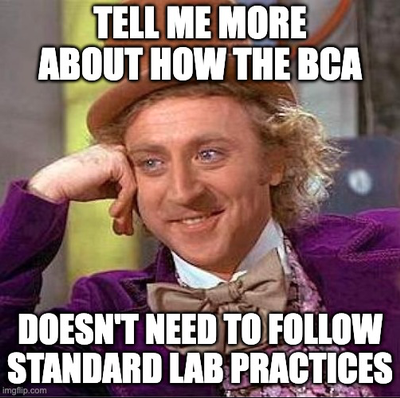BCA Blood/Urine Alcohol Lab Refuses to Follow Basic Quality Assurance Standards
In the past few weeks, I’ve pointed out multiple errors committed by the Bureau of Criminal Apprehension’s (BCA’s) breath alcohol lab. I’ve uncovered a massive blunder they made when creating their acetone solution, their insistence on hiding bias under a bell curve, and their failure to have the source code of their breath alcohol machines independently reviewed.
It turns out their blood and urine alcohol lab has big problems as well.
Let’s take a look.

Refusal to calibrate their pipette
In science, it’s standard practice to make sure that the equipment you are using is calibrated. This helps ensure that your results are accurate and reliable.
The scientific term for this is traceability.
A blood alcohol of 0.08 g/100ml needs to measure the same whether you are in France, the UK, or Minnesota. Scientists need to be able to trace their measurements back to a globally recognized standard.
The only way to maintain traceability is to use calibrated equipment and follow good lab practices. But the BCA refuses to do this.
The ASB Standard Practices for Measurement Traceability in Forensic Toxicology clearly states:
All pipettes, pipette diluters, automatic diluters, and syringes used for the preparation of calibrator solutions that require measurement traceability or in sample preparation (e.g. sample aliquoting and ANSI/ASB Standard 017, 1st Ed. 2018 8 other steps that affect overall measurement uncertainty) shall be calibrated at least annually by an appropriately accredited calibration service supplier. Autosampler syringes used for sample introduction to analytical instrumentation (e.g., gas chromatograph, liquid chromatograph, or immunoassay) do not require calibration.
The above standard only excludes one thing from calibration, and that is the syringe used to inject the blood or urine into the instrument. Everything else must be calibrated -- including the pipette used for alcohol analysis.
The State argues that since it uses certified reference material to calibrate its instrument, they don’t need to use a calibrated pipette. This is a sad post hoc explanation for why they failed to follow basic lab quality assurance.
There’s an old adage that says: garbage in, garbage out.
It tells us that if we start off on the wrong foot, we’ll get bad results. If the BCA teaches (calibrates) the instrument with a pipette that is out of tolerance, it will likely get bad results.
The strange thing about this argument is that every other pipette in the BCA’s toxicology lab is regularly calibrated! For some reason (ie. we made a huge effing mistake), they think it’s OK not to calibrate the most frequently used one -- the one used to analyze alcohol.
More to come
As I dig through the discovery for upcoming blood and urine cases, I’m finding many more anomalies that need to be explained. Stay tuned. I’ll be posting my findings as I go.
Follow me on LinkedIn for real-time updates.

